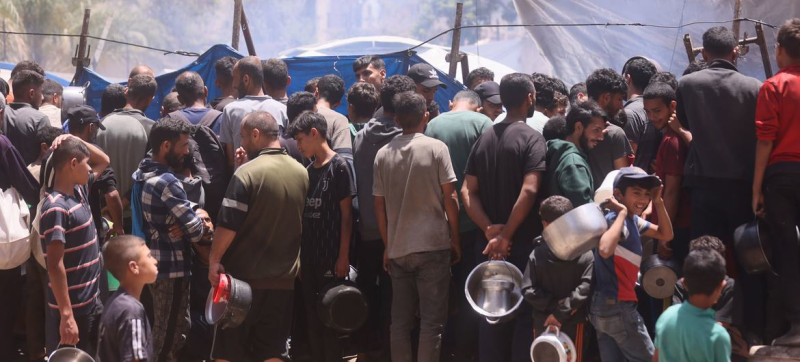- UK Pledges Aid to Support Rohingya Refugees and Host Communities |
- Investors and Officials Challenge Elon Musk’s $1 Trillion Pay |
- Global Protests Erupt Over Israeli Blockade of Gaza Flotilla |
- Dhaka’s air quality recorded moderate Friday morning |
- Nabaganga River erodes homesteads in Par Bishnupur, Narial |
Gaza Health System Strained as 42,000 Suffer Severe Injuries

People gather at a food distribution site in Gaza.
Nearly 42,000 people in Gaza are living with life-changing injuries from the ongoing conflict—including more than 10,000 children—as the health system collapses under relentless strain, the World Health Organization (WHO) warned on Thursday.
“These life-changing injuries account for one quarter of all reported injuries, out of more than 167,300 people injured since October 2023,” said Rik Peeperkorn, WHO Representative in the West Bank and Gaza.
Over 5,000 people have suffered amputations or other severe injuries to their arms, legs, and spinal cord.
Briefing journalists in New York by video link from Gaza, Dr. Peeperkorn highlighted widespread trauma needs, noting that dozens of rehabilitation workers have been killed and facilities are close to collapse.
“Currently, fewer than 14 of Gaza’s 36 hospitals remain partially functional, while less than one-third of pre-conflict rehabilitation services are operating, with several facing imminent closure,” he said.
Maternity and childbirth services have also been severely affected. The UN reproductive health agency, UNFPA, estimates that 55,000 pregnant women are trapped in Gaza, facing displacement, bombardment, severe hunger, and malnutrition.
Approximately 130 babies are born daily, with more than a quarter delivered by Caesarean section. Every week, at least 15 women give birth outside health facilities without skilled help, and around one in five newborns are premature or have low birth weight.
James Elder from UNICEF described conditions at Al Aqsa and Nasser hospitals: “There’s a real level of fear and stress among the community in Gaza City and the south. Hospitals are overburdened, with large numbers of mothers and newborns in corridors due to the devastation of healthcare facilities.”
Conflict-related injuries also leave deep psychological scars. “Survivors struggle with trauma, loss, and daily survival, while psychosocial referral services remain scarce,” Dr. Peeperkorn said, urging investment in rehabilitation linked to mental health and disability-inclusive care.
WHO stressed the urgent need for fuel, medical supplies, prosthetics, and assistive devices, alongside protection for health workers. Medical evacuation is another priority. More than 15,000 people, including 3,800 children, require specialist treatment outside Gaza.
“We need many more countries to accept patients, and the restoration of the West Bank and East Jerusalem referral pathway,” Dr. Peeperkorn added.
Humanitarian officials highlighted the wider crisis facing civilians with nowhere to go. UN Deputy Spokesperson Farhan Haq said more than 6,700 people fled northern Gaza to the south within 10 hours on Wednesday alone, adding to over 417,000 displacements since mid-August.
“Families in southern Gaza are squeezed into overcrowded shelters or makeshift tents along the coast. Many others sleep out in the open, amid rubble. New arrivals face poor sanitation, no privacy or safety, and a high risk of children being separated from their families—all while exposed to explosive ordnance,” he said.

